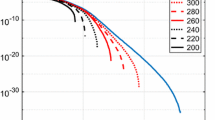Abstract
Many different fields, such as terrain analysis, medical imaging, and of course the Geosciences, have used the curvature of their data for many years to enhance subtle details. Despite the fact that the calculations of the curvature are based on second-order derivatives of the data and are therefore sensitive to noise, curvature has proved itself to be a useful aid to the interpretation of the data. Although there are many different curvatures that can be computed from a 2D (map) dataset, they all have a response that depends on the amplitude of the data, so that small-amplitude features can be missed. This manuscript shows how amplitude-balanced curvatures can be computed, and the technique is demonstrated on synthetic data and also on gravity and magnetic datasets from South Africa.




Similar content being viewed by others
Data availability
The gravity and magnetic data used belongs to the Council for Geoscience, Pretoria.
References
Al-Dossary S, Marfurt KJ (2006) 3D volumetric multispectral estimates of reflector curvature and rotation. Geophysics 71(5):P41–P51
Blakely RJ (1995) Potential theory in gravity and magnetic applications. Cambridge University Press 441pp
Blumentritt CH, Marfurt KJ, Sullivan EC (2006) Volume-based curvature computations illuminate fracture orientations — Early to mid-Palaeozoic, Central Basin Platform, west Texas. Geophysics 71:159–166
Cevallos C, Kovac P, Lowe S (2013) Application of curvatures to airborne gravity gradient data in oil exploration. Geophysics 78(4):G81–G88
Cooper GRJ, Cowan DR (2009) Terracing potential field data. Geophys Prospect 57:1057–1061
Eales HV (2001) A first introduction to the geology of the Bushveld complex and those aspects of geology that relate to it. Council for Geoscience, Pretoria 84pp
Gonzalez RC, Woods RE (2008) Digital image processing, 3rd edn. Pearson 976pp
Lee MD, Morris M, Leblanc G, Harris J (2013) Curvature analysis to differentiate magnetic sources for geologic mapping. Geophys Prospect 61:572–585
Li X (2015) Curvature of a geometric surface and curvature of gravity and magnetic anomalies. Geophysics 80(1):G15–G26
Miller HG, Singh V (1994) Potential field tilt – a new concept for location of potential field sources. J Appl Geophys 32:213–217
Mitasova H, Jarosalav H (1993) Interpolation by regularized spline with tension: II. Application to terrain modelling and surface geometry analysis. Math Geol 25:657–669
Phillips JD, Hansen RO, Blakely RJ (2007) The use of curvature in potential-field interpretation. Explor Geophys 38:111–119
Roberts A (2001) Curvature attributes and their applications to 3D interpreted horizons. First Break 19(2):85–100
Therriault A, Grieve RAF, Reimold WU (1997) Original size of the Vredefort structure: implications for the geological evolution of the Witwatersrand Basin. Meteorit Planet Sci 32:71–77
Author information
Authors and Affiliations
Corresponding author
Ethics declarations
Conflict of interest
The authors declare that they have no conflict of interest.
Additional information
Responsible Editor: Narasimman Sundararajan
Rights and permissions
About this article
Cite this article
Cooper, G.R.J. Amplitude-balanced curvatures of geophysical data. Arab J Geosci 14, 280 (2021). https://doi.org/10.1007/s12517-021-06595-5
Received:
Accepted:
Published:
DOI: https://doi.org/10.1007/s12517-021-06595-5




